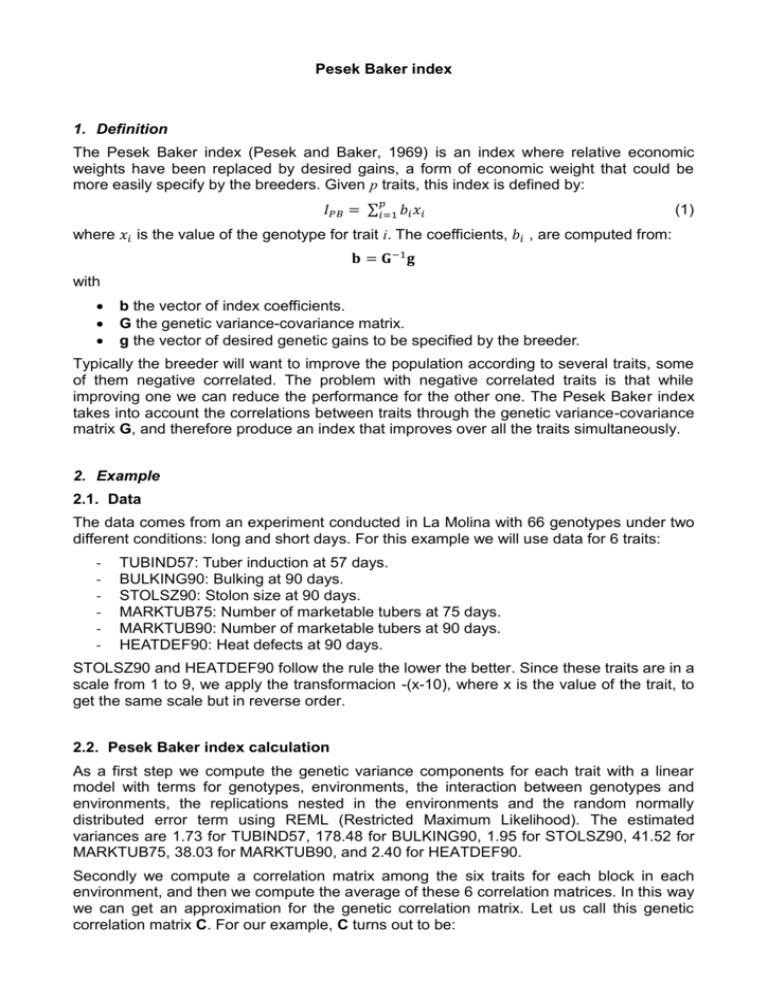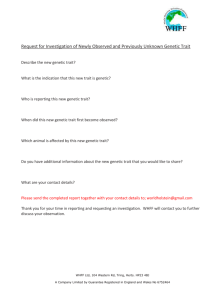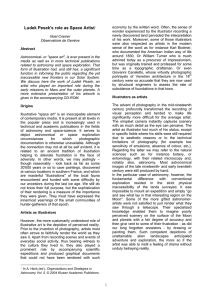Selection index potato
advertisement

Pesek Baker index 1. Definition The Pesek Baker index (Pesek and Baker, 1969) is an index where relative economic weights have been replaced by desired gains, a form of economic weight that could be more easily specify by the breeders. Given p traits, this index is defined by: 𝐼𝑃𝐵 = ∑𝑝𝑖=1 𝑏𝑖 𝑥𝑖 (1) where 𝑥𝑖 is the value of the genotype for trait i. The coefficients, 𝑏𝑖 , are computed from: 𝐛 = 𝐆−1 𝐠 with b the vector of index coefficients. G the genetic variance-covariance matrix. g the vector of desired genetic gains to be specified by the breeder. Typically the breeder will want to improve the population according to several traits, some of them negative correlated. The problem with negative correlated traits is that while improving one we can reduce the performance for the other one. The Pesek Baker index takes into account the correlations between traits through the genetic variance-covariance matrix G, and therefore produce an index that improves over all the traits simultaneously. 2. Example 2.1. Data The data comes from an experiment conducted in La Molina with 66 genotypes under two different conditions: long and short days. For this example we will use data for 6 traits: - TUBIND57: Tuber induction at 57 days. BULKING90: Bulking at 90 days. STOLSZ90: Stolon size at 90 days. MARKTUB75: Number of marketable tubers at 75 days. MARKTUB90: Number of marketable tubers at 90 days. HEATDEF90: Heat defects at 90 days. STOLSZ90 and HEATDEF90 follow the rule the lower the better. Since these traits are in a scale from 1 to 9, we apply the transformacion -(x-10), where x is the value of the trait, to get the same scale but in reverse order. 2.2. Pesek Baker index calculation As a first step we compute the genetic variance components for each trait with a linear model with terms for genotypes, environments, the interaction between genotypes and environments, the replications nested in the environments and the random normally distributed error term using REML (Restricted Maximum Likelihood). The estimated variances are 1.73 for TUBIND57, 178.48 for BULKING90, 1.95 for STOLSZ90, 41.52 for MARKTUB75, 38.03 for MARKTUB90, and 2.40 for HEATDEF90. Secondly we compute a correlation matrix among the six traits for each block in each environment, and then we compute the average of these 6 correlation matrices. In this way we can get an approximation for the genetic correlation matrix. Let us call this genetic correlation matrix C. For our example, C turns out to be: 1 0.0657 0.3787 0.1582 0.0301 0.3240 1 0.1781 0.4422 0.6802 0.1373 1 0.1698 0.0805 0.4221 C . 1 0.4373 0.0830 1 0.0004 1 Multiplying the entries of this genetic correlation matrix with the corresponding variances and standard deviations computed in the first step, we can get an approximation for the genetic variance-covariance matrix G. The resulting matrix for our data is: 0.6609 1.735 1.157 0.6966 1.343 0.2441 178.5 3.324 38.07 56.04 2.841 1.951 1.529 0.6932 0.9130 G . 41.52 17.38 0.8281 38.03 0.003540 2.398 We can also compute heritabilities with the variance components estimated in the first step using formula h2 2 G G2 G2 E e e2 (2) er 2 where 𝜎𝐺2 is the genetic variance, 𝜎𝐺×𝐸 is the variance for the interaction between 2 genotypes and environments, 𝜎𝑒 is the error variance, e the number of environments (2 in this case) and r the number of replications (3 in this case). Here we get: 78.88 78.25 81 . 89 h2 . 64 . 90 57.29 84.47 Now we need to define the vector of desired genetic gains, g. A good practice in order to get a sensible index that accommodates all the traits and gives an appropriate weight to all of them is to use the standard deviations for g, so we have: 1.317 13.36 1.397 g . 6.444 6.166 1.548 Finally, the index coefficients are: 0.3934 0.0046 0 . 3986 b G 1g . 0.0610 0.1322 0.3592 (3) Heritability is defined by the ratio between the genetic and the phenotypic variance. From formula (2) we see that the phenotypic variance for this example is defined by P2 G2 G2 E e2 . e er We have estimates for the phenotypic variances that have been used to compute the heritabilities. Using these estimates and the covariances on matrix G, we can estimate a phenotypic covariance matrix P: 0.6609 2.199 1.157 0.6966 1.343 0.2441 228.1 3.324 38.07 56.04 2.841 2.383 1.529 0.6932 0.9130 P . 63 . 97 17 . 38 0 . 8281 66.38 0.003540 2.839 Now we can compute the response to selection for each trait using formula Rj i b'c j b' Pb V ( y j ) where i is the selection intensity that corresponds to a selected fraction , cj is the j-th column of matrix G and V(yj) the variance for trait j. For our example, if we want to select the superior 10%, then the 0.9 quantil of the normal distribution is 1.282, the ordinate of the normal density at this point is 0.1755 and the selection intensity is i 0.1755 1.755 . 0.1 The b' Pb product is 3.679, and the response to selection for each trait result (below the example for trait 1): R1 1.755 0.39 1.73 0.0046 1.16 0.40 0.70 0.061 1.34 0.13 0.24 0.36 0.66 3.679 1.73 0.915 Since we are using standardized units (remember we used the standard deviations in vector g to compute b, see formula (3)), we will get the same result for each trait, so the response to selection is 0.915 standard deviations. We can multiply this value by the standard deviations to get the response to selection in actual units: For TUBIND57: 0.915 × 1.3171 = 1.205 points. For BULKING90: 0.915 × 13.3595 = 12.22 %. For STOLSZ90: 0.915 × 1.3969 = 1.278 points. For MARKTUB75: 0.915 × 6.4437 = 5.895 tubers. For MARKTUB90: 0.915 × 6.1665 = 5.642 tubers. For HEATDEF90: 0.915 × 1.5485 = 1.417 points. An important question is how this selection index correlates with each of the traits. To see this we plot the index and the mean value of the trait for each genotype. Let us see now how the index behaves for each environment. For the short days environment we have and for the long days environment Which are the best clones according to this index? In the table below we show the top 10 clones over both environments and in each environment. Top 10 clones selected with the Pesek Baker index in two environments Ranking Best over both environments Best on the short days environment Best on the long days environment 1 CIP-300072.1 CIP-300072.1 CIP-300072.1 2 CIP-300048.12 CIP-301023.15 CIP-300048.12 3 Atlantic CIP-300056.33 Atlantic 4 CIP-397077.16 CIP-300048.12 CIP-390478.9 5 CIP-390478.9 CIP-397077.16 CIP-397077.16 6 CIP-301023.15 CIP-301024.14 CIP-300054.29 7 CIP-392973.48 CIP-392973.48 CIP-392973.48 8 CIP-300056.33 CIP-390478.9 CIP-397014.2 9 CIP-388676.1 CIP-301045.74 CIP-301023.15 10 CIP-301045.74 CIP-388676.1 CIP-388676.1 References Pesek, J. and R.J. Baker.(1969). Desired improvement in relation to selection indices. Can. J. Plant. Sci.9:803-804.








